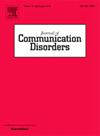测量疑似神经发育障碍婴儿父母的沟通方式:RAACS仪器的信度检验和适应性
IF 2.1
3区 医学
Q2 AUDIOLOGY & SPEECH-LANGUAGE PATHOLOGY
引用次数: 0
摘要
本研究采用响应性增强和替代沟通风格量表第3版(RAACS 3)来评估12 - 60个月大的沟通障碍儿童父母的沟通风格,并证明了其有效性和可靠性。本研究的目的是调查RAACS应用于疑似神经发育障碍的父母和婴儿(4至12个月)之间的视频记录通信时的可靠性,如果需要,调整和重新测试该仪器。方法4名语言病理学家使用26段父母与婴儿互动的录音录像进行了三阶段可靠性测试。计算了内部和内部的协议。在第一阶段,使用了原始仪器RAACS 3,录制了20张唱片。在第二阶段,该仪器进行了调整,以更好地适应目标群体(4至12个月婴儿的父母),并被称为RAACS 4。在第三阶段,RAACS 4在六种新的音像制品上进行了试验。这一阶段还包括两次联合评级和评级程序之前评级员之间的协商一致讨论。结果第一阶段的测试显示RAACS 3独立于统计检验方法的信度较低。在第三阶段进行的试点测试表明,改进型RAACS 4具有更高的可靠性。结论raacs 3量表对婴幼儿父母沟通方式的评价不可靠。RAACS 4在评估神经发育迟缓婴儿父母的沟通方式时显示出令人鼓舞的结果。需要进一步的信度和效度调查。本文章由计算机程序翻译,如有差异,请以英文原文为准。
Measuring communicative style in parents of infants with suspected neurodevelopmental disorders: Reliability test and adaptation of the RAACS instrument
Introduction
The Responsive Augmentative and Alternative Communication Style Scale, version 3 (RAACS 3) has been used when assessing communicative style in parents of children with communicative disabilities between 12 and 60 months of age and it has demonstrated validity and reliability. The aim of this study was to investigate the reliability of RAACS when applied to video-recorded communication between parents and their infants (aged four to 12 months) with suspected neurodevelopmental disorders, and, if needed, adapt, and retest the instrument.
Method
Four speech language pathologists performed a three-phase reliability procedure using twenty-six audio-video recordings of interactions between parents and infants. Inter- and intrarater agreement was calculated. In phase I the original instrument RAACS 3 was used, on twenty recordings. In phase II the instrument was adapted to better suit the target group (parents of infants aged four to 12 months) and was called RAACS 4. In phase III RAACS 4 was pilot tested on six new audio-video recordings. This phase also included two joint ratings and a consensus discussion between the raters preceding the rating procedure.
Results
The testing during phase I showed low reliability rates of RAACS 3 independent of statistical test method. The pilot testing that was done during phase III showed that the adapted version, RAACS 4, had higher reliability rates.
Conclusions
RAACS 3 was not reliable for assessment of communicative style in parents of infants. RAACS 4 showed promising results when assessing communicative style of parents of infants with neurodevelopmental delays. Further reliability and validity investigation is needed.
求助全文
通过发布文献求助,成功后即可免费获取论文全文。
去求助
来源期刊

Journal of Communication Disorders
AUDIOLOGY & SPEECH-LANGUAGE PATHOLOGY-REHABILITATION
CiteScore
3.30
自引率
5.90%
发文量
71
审稿时长
>12 weeks
期刊介绍:
The Journal of Communication Disorders publishes original articles on topics related to disorders of speech, language and hearing. Authors are encouraged to submit reports of experimental or descriptive investigations (research articles), review articles, tutorials or discussion papers, or letters to the editor ("short communications"). Please note that we do not accept case studies unless they conform to the principles of single-subject experimental design. Special issues are published periodically on timely and clinically relevant topics.
 求助内容:
求助内容: 应助结果提醒方式:
应助结果提醒方式:


